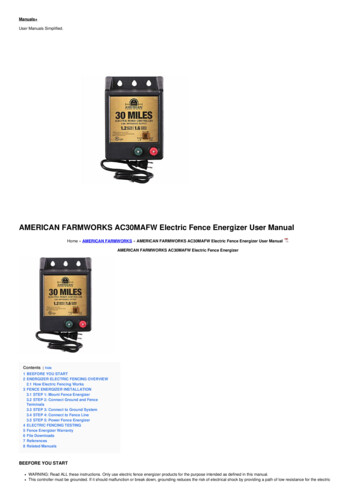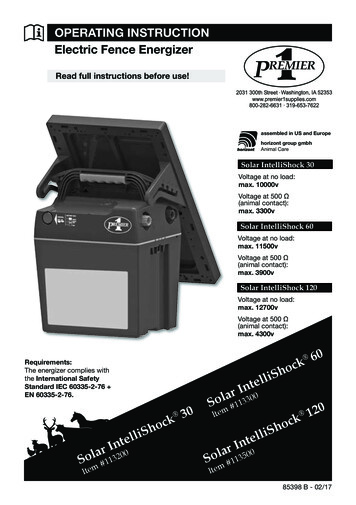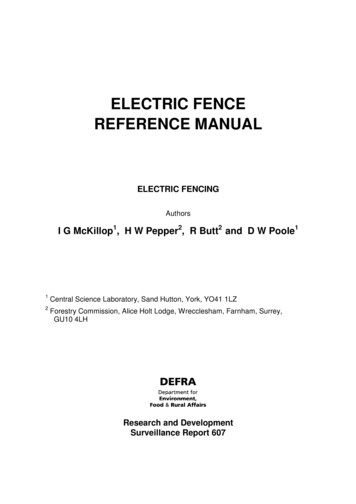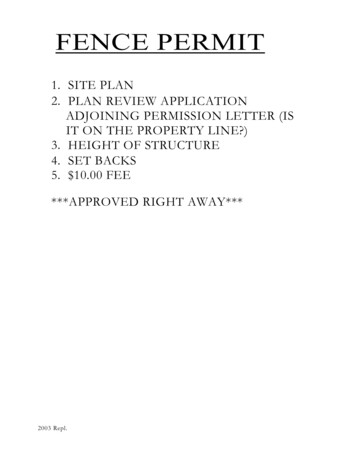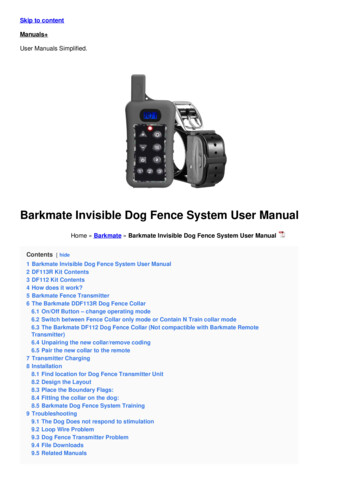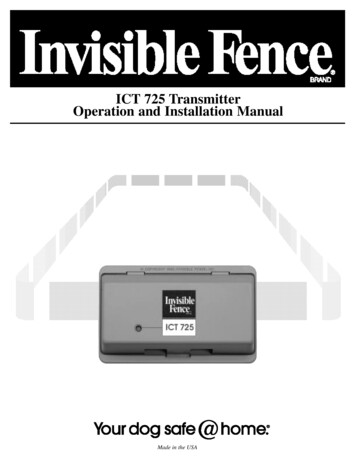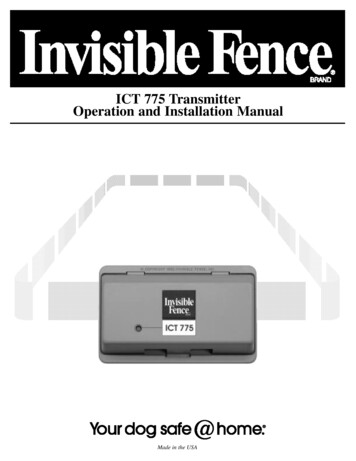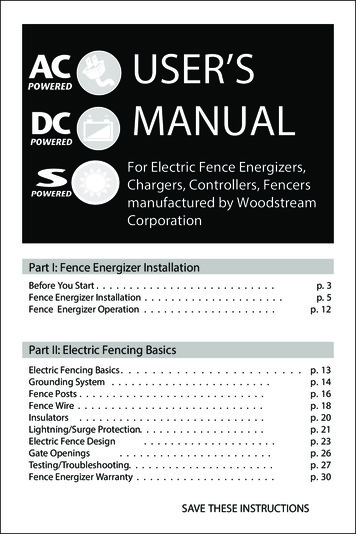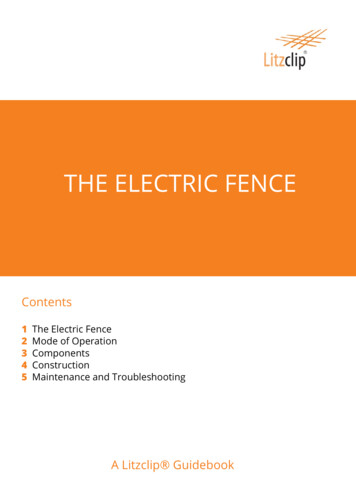
Transcription
THE ELECTRIC FENCEContents12345The Electric FenceMode of OperationComponentsConstructionMaintenance and TroubleshootingA Litzclip Guidebook
1. The Electric Fence2. The OperationThe most common enclosure on today’s livestock farms is the electricfence. Farmers in the United States and New Zealand have been usingelectric fences to enclose their herds since the 1930s.In 1942, the first wire fence energizer was invented by Paul Kolb inGermany. The technology has been pushed and developed furtherand further, and today there are even solar-powered electric fencesand electric fences with GPS transmitters.In the early days, electric fences were made of conductive steel wire.This was obviously quite expensive, rigid and hard to assemble.Today, fences can be assembled and repaired more quickly, easily andcost effectively using wires woven in plastic in the form of strands,cords and tapes. And in the case of a mobile enclosure, the fences canbe disassembled and reassembled with ease.Litzclip shows you what to watch out for during the construction,maintenance, or repair of electric fences. This way your animals aresafe and happy, and you can rest assured it will last in the long run.An electric fence consists of the following components:a)b)c)d)e)f)g)2A Litzclip Guidebook litzclip.comA fence energizer which generates regular current pulses.A cable that transmits the electrical impulses to the fence.Wires that conduct the electricity interwoven withstrands of plastic.Several fence posts (made of steel, wood or plastic) that can bemoved or replaced depending on your needs.Insulators on the fence posts which isolate the electricity fromthe ground.A steel “earth” rod that is driven 1m into moist earth provides thegrounding of the electric fence. Strong electrical fences mayrequire up to three ground rods to be driven into the ground at adistance of 3m.Additional components are available as needed, such asconnectors, gates and gate handles.A Litzclip Guidebook litzclip.com3
3. Components of an Electric FenceHow it worksThe aim of an electric fence is the “psychological barrier.” If an animal(or human :-)) contacts the fencing rope or band, it (he/she) receivesan unpleasant but harmless electric shock.The animal associates thefence with the unpleasant shock and learns to stay away from it.(Unlike we humans :-)The circuit is NOT closed or completed by the fence itself. Only whenan animal touches the fence, the circuit is completed and the currentflows through the animal and the earth back to the pasture fencedevice. A clean grounding is therefore vitally important for the fenceto work reliably.Electric fence energizerThe electric fence energizer is the heart of apasture fence. It delivers the impulses ofelectrical current along the fence, which theanimal experiences as an electric shock.The power for the device itself can be suppliedfrom a 230 V power outlet or a 9 V or 12 Vbattery. There are also multifunctional devicesthat can be operated at 230 V as well as on abattery. Auxiliary solar operation is also possible.The choice of the fence energizer depends on several factors:1. If there is a 230 V power outlet nearby, a network-connecteddevice is definitely preferable. This guarantees a stable and consistentsupply of power to the fence. If there is no electricity nearby, a 12 Vdevice is necessary for a device requiring high power, a 9 V device issufficient for a lower power requirement.2. The required power of the unit is determined by the length of thepasture fence, the amount of fence along the fence and, ofcourse, the nature of the animals being held. Two electricalquantities are relevant: the operating voltage in Volts and theimpulse strength in Joules.4A Litzclip Guidebook litzclip.comA Litzclip Guidebook litzclip.com5
The operating voltage needs to correspond to the voltage at anormal load condition, like when an animal or some type ofvegetation touches the fence. You would therefore calculate with anadditional resistance of 500 Ω due to the touch. The minimum loadvoltage of a fence should not be less than 2,000 V. This voltage issufficient for animals that have a thin coat and become accustomedto pasture fences. i.e. horses, cattle or pigs. For animals with a thickcoat, or for those more eager to escape the fences (sheep, goats andpoultry for example) the output voltage should not fall below 4,000 V.However, even without being touched, no fence is free from somedischarge. Defective insulators, vegetation, fallen branches, humidity— all of this leads to a reduction in voltage across the fence. In orderto guarantee the minimum load voltage, the pasture fence must havea higher output voltage. Strong devices can reach over 10,000 V.The same is true for the impulse strength: for animals with thin furand smaller fences, smaller impulse energies of up to 1 Joules shouldsuffice. For large fence assemblies, animals with thick fur, or for areaswith more predators you will need more powerful equipment with animpulse energy of up to 5 Joules. Side effects: The higher the pulsestrength, the greater chance that plant growth that touches the fenceis destroyed.The earthing — grounding rods and ground connection cablesAs previously described, a clean grounding is essential for smoothoperation of the electric fence. Since the fence energizer is connectedwith the fence and the earth, there is a voltage between fence andground. If an animal standing on the ground touches the fence, thecircuit is completed and the current flows through the animal and theearth back to the device. The lower the resistance, the better the currentflows. The earth can present very high resistance and thus impair thefunction of the pasture fence.The purpose of the grounding is therefore to minimize the groundresistance. This is achieved by good conductivity of the earth, severalgrounding rods, and a careful connection of the grounding rods with thepasture fence. The conductivity of the earth is improved by moisture.Dry soil is not suitable for electrical grounding. In dry soil, the earth‘sresistance can be reduced by using more grounding rods.The grounding rods are made of stainless steel and should be atleast one meter long and should be driven 1 meter deep into theearth. If several rods are used, the distance between them must be atleast 3 m.3. Of course, you can also pay attention to the electricityconsumption when you purchase a pasture fence (in watts / hour) tokeep operating costs low .The grounding rods are then connected underground in series with ahigh-voltage cable. The first grounding rod is then connected to theground terminal of the fence energizer.You will find detailed information and recommendations on individualfence energizers in the product descriptions in online shops, or youcan consult the specialist trade.Pulse energy plays a role when considering the number of groundrods. For 1 Joule electric fences, a ground rod of 1m is usuallysufficient. For 2 to 5 Joule electric fences, at least 2 or 3 1m groundrods should be used.Here you can find fence energizers by AKO.And don‘t forget to keep at least 10m distance from othergrounding systems. Otherwise, a flashover of voltage may occur.6A Litzclip Guidebook litzclip.comA Litzclip Guidebook litzclip.com7
Conductor materialIn certain respects, it is „the fence“.The conductor material transports the current through the fence.If you build a solid fence that will last several years, solid wire madeof steel or iron is suitable for it. Wire is very stable and has a highconductivity. However, it is also very expensive and difficult to set upand to tighten.For all other fences, I recommend you use conductor materials madeof plastic. Here, thin, conductive wires are interwoven with plasticropes or tapes. That makes the conductor material flexible, stretchable,light, inexpensive, and the fence is quickly and easily mounted anddisassembled. And the risk of injury to animals is very low.When choosing the right conductor material, the following thingshave to be considered:The larger the pasture, the longer the fence, the longer the distancethe electricity has to travel to ensure the minimum output voltage atthe other end of the fence. The decisive criterion for this is theresistance of the conductor material, stated in Ω/m. The lower theresistance, the less power is lost along the way. Conductor materialwith more than 3 Ω/m is only suitable for smaller fences. Fences madeof conductive material less than 1 Ω / m can be several kilometerslong. The recommended maximum fence length is usually given in theproduct description of the conductor material.The woven wires are usually made of stainless steel or tin-platedcopper. Stainless steel is not as good as copper, but it is moreresistant to breaking. Cheaper conductor materials for smaller fencesare primarily made of stainless steel.Tinned copper is an excellent conductor, but it is not as stable asstainless steel. Therefore, a mixture of the two types of wire isGrounding accessories at AKO8A Litzclip Guidebook litzclip.comA Litzclip Guidebook litzclip.com9
inserted into better quality conductor materials. These conductormaterials are also suitable for large pastures.So:Cost-effective conductor material for short pasture fences higherohm value and wires made of stainless steel.High-quality conductor material for long pasture fences low ohmvalue and wires made of stainless steel and copper.There are three different types of synthetic conductive materialon the market: a litz wire, rope and band (also known as tape).A litz wire is a thin cable with a 2 to 3 mm diameter. It is very easy touse and cost effective. Therefore, they are very well suited for mobilefences. Nets for i.e. sheep or poultry consist of such wire.A pasture fence rope is thicker and consists of more conductivewires than cable. Averages of 6 to 8 mm are customary. Ropes aremore stable than cable and also more visible to animals. Thus,pasture fence ropes are particularly suitable for larger animals,e.g. cattle. Pasture fence ropes are used in areas where there arestronger weather influences, since they are are quite insensitive towind and snow, for example.more susceptible to weather conditions, but can be countered withcareful and regular (re-)tightening of the band. The thinner bands arealso used for cattle.Tapes are not suitable for sheep: in order to get an electric shock,the animal must have skin contact with the conductor. Thin ropesand strands penetrate much better through the dense, insulating fur(wool) than wide bands.The conductor material is connected to the pasture fence by a fenceconnection cable.Conductor material at AKOFence connection cable at AKOThe pasture fence band (or tape) is available in thickness of 12.5mm, 20 mm, and 40 mm. It is mainly used for paddocks, often incombination with a rope, because the bands are very stable and caneasily be seen by the animals. Thanks to the use of wide band, thereis less contact between animals and the pasture fence. It is somewhat10A Litzclip Guidebook litzclip.comA Litzclip Guidebook litzclip.com11
Electric Fence PostsWhich electric fence posts you will use, depends on the localconditions. For example: the soil, the size of your pasture and thescenic appearance, and the type of electric fence.Basically, electric fence posts perform two different tasks:1. The corner or solid fence post forms the framework of yourfence. These posts must be very stable since they need to withstandthe physical tension of the pasture fence material.3. Mobile fences are put up and taken down several times per yearas required. Therefore, easily installed plastic poles or even T-postsare used most of the time. Reinforced, long plastic poles or T-postsshould be used for the corner posts. Both variants usually have knobsover the entire length so that accessory parts, in particular insulators,can simply be clipped on where needed.The distance between posts should be, as a rule, 4 to 5 m.Depending on the terrain, the distances can also be shorter or longer.2. The extender posts only carry the conductor material, so they arenot exposed to any tension. However, they must be stable enough notto fall or break when animals run into the fence.The following posts are used depending on the type of the electricfence:1. Permanent fences often remain in place for several years. Here,wood posts, recycled posts or steel T-posts are usually used. All postsare driven deep into the ground, ideally up to one third of their totallength. Recycled posts can be treated like wood posts (ie: sawn,drilled, etc.) If the ground is too hard for wood or recycling posts,T-posts made of stainless steel may be used.WoodPlasticRecycledT-PostFence posts at AKO2. Semi-fixed fences are generally put up at the beginning of theseason and taken down again at the end of the season. Wood posts,recycled fence posts, or T-posts are used as sturdy corner posts. Therest of the posts in between can be made of plastic. Plastic posts arefully insulated and very easy to assemble and dismantle.12A Litzclip Guidebook litzclip.comA Litzclip Guidebook litzclip.com13
InsulatorsConnectorInsulators separate the conductor material from the fence posts sothat the current is not discharged into the earth via the posts. Thelarger the insulators, the better their insulation properties.Connectors are used in many places in the electric fence. Mostobviously, they serve as the connection between two currentcarrying conductor materials. For example, connecting the end of apasture fence rope with the beginning of the next rope. If you wouldsimply tie the two ends of the ropes together, the power flow can nolonger be guaranteed and the wires would break. The connectorstherefore allow for the electricity to flow unhindered.Similar to the posts, insulators also satisfy two different tasks:1. Insulators, which stretch and maintain, are placed on the corneralong with tension posts.2. Guiding insulators are attached to the posts and keep theconductor material at the correct height so that the elasticity of thefence is not compromised. The conductor material on the postsshouldn‘t be held in place at all by the insulators and should movefreely in the insulator.In addition, there are a number of different insulators to choosefrom depending on the shape of the pole, the method of connectionor the type of conductor material.The most common guide insulator is the classic ring insulator.Corner insulators are particularly stable as they must withstand thepull of the conductor material. They are also used at the beginningand at the end of the conductor material. There are special insulatorsfor electric ropes and bands. For the gate handles you also needspecial gate grip insulators.Ring InsulatorCorner InsulatorBand InsulatorYou need connectors to repair cracked or damaged conductormaterial. If the wires are broken in one place in the conductormaterial, you can just cut it and connect the ends with a connectoragain.The simplest, fastest and most economical connectors are Litzclip connectors. They are available for strands, ropes, tapes and nets.They can be attached without tools and without the help of anadditional person. Simply thread the conductor material in on bothsides, pull the plastic cap over it, and you‘re done.Gate handle InsulatorInsulators at AKO14A Litzclip Guidebook litzclip.comA Litzclip Guidebook litzclip.com15
Connectors are also used at the beginning of a conductor material.The conductor material must be mounted somehow on the postinsulator. You can use a Litzclip here, too. Simply cut open one sidewith a side cutter and clip it on the insulator. Don‘t worry — it will hold!If you‘re working with pasture fence tape, you can also use the Litzclip gate handle connector.And at the end of the conductor material, I recommend you attach aLitzclip gate connector so you can simply add tension to your pasturefence and re-tension it with a few movements at any time.The use of pasture fences requirea regular tensioning since it issomewhat more vulnerable to windand weather.Connectors at AKO16A Litzclip Guidebook litzclip.comLightning protection, fence switches and FI circuit breakersThe electric current of a pasture fence is unpleasant, but it is harmlessfor animals and humans.Nevertheless, electricity can always be life-threatening.Particularly when using 230 V fence energizers connected to a socketin the house, stable or other buildings. You should take as manysafety precautions as possible in order to avoid the risk of alife-threatening electric shock.It is imperative to install a FI protection switchbetween the wall socket and fence energizer.Should a problem in the power circuit appear(so that the electricity provided cannot flow backto the energizer), the residual current circuitbreaker „immediately“ — within milliseconds —separates the energizer from the power supplythrough the outlet. Whew — life saved.A lightning protection device is highlyrecommended. Electric pasture fencesare excellent lightning conductors dueto the grounding, which is why lightningstrikes can often occur. The excessivevoltage of a lightning strike destroys thepasture fence. When this happens:a) the fence is no longer functionaland you may have to catch your animalsagain and,b) you will have to buy a new pasturefence. It is even worse if the energizer is connected to a socketbecause the lightning strike can flow directly into the socket and cantrigger a house fire. Of course, as stated above, a residual-currentcircuit breaker can help.A Litzclip Guidebook litzclip.com17
The lightning protection device is installed between the fence and theelectric fence energizer and connected to the ground. Becauseelectricity travels the way of least resistance, the power is caught atthe „additional resistance“ protection device and sent into the groundbefore it reaches the energizer. Phew — we were lucky.As a last safety link in the chain, you can alsoinstall a fence switch between fence andlightning protection device. For example, incase of threatening thunderstorm, you canturn the fence off with the switch (do nottell the animals). The fence switch is alsogrounded and thus directs the flash directlyinto the ground before the lightning protectiondevice. Check after a lightning strike whetherlightning protection and fence switchesare still functional. Fence switches are also useful if you‘ve fencedseveral animals separately. Then you can quickly switch off individualcouplers on site.Lightning protection at AKOSwitches at AKOThe entire current protection chain then looks as follows:The gateOf course, you have to enter your fenced pasture somehow.There are two possibilities:Either you install a proper gate, for example out of steel, which makessense only with a permanent fence, or there is a spot somewhere onyour fence where you can open the conductor material. No matterwhich version you choose — the two gate posts must be stable,fixed fence posts.If you make a passage way by interrupting the pasture fence tapeor rope, connect the ends of the conductor material with the Litzclip gate handle connector on a gate handle, then simply hang it on acorner insulator on the fence post. As a result, current conductionthrough the gate is ensured. Gates and openings in pasture fencesare often weak points in the current flow if they are not properlyconnected. The conductor material in the pass through area canprovide good tension through the tension spring integrated in the gatehandle. At the other end, the conductor material must of course befirmly attached to the gate fence post.If you want the power supply in your pasture fence to be secured evenafter you have unhooked the gate handles, you have to connect thefence with a high voltage insulated ground cable, before and after theopening.Caution: If you place the conductive material on the ground duringopening, there is no current left on your fence since it is dischargedinto the ground.Gate systems at AKO
4. The Construction of an Electric FenceA smooth construction starts with a careful plan! Consider carefullywhat you need, the topography of your land, and how long your fencewill need to be in place.For a specific list of requirements, I recommend the online electricfence calculator from AKO.When you have everything together, begin by setting the piles. Thenyou attach the insulators at the required height of the posts. Fastenthe conductor material at the starting point and guide it through theinsulators. Connect the ends of the conductor material if necessarywith a Litzclip connector. You can connect the ends of the wire, asdescribed above, to the gate handle on the fence post. Rememberthat you must not create a closed circuit. The circuit closes only whenan animal standing on the ground touches the fence.After this, add some warning signs — warning signs have to be addedon public roads!After that you can switch on your electric fence.Warning signs at AKOSelect a suitable location for your fence energizer, e.g. a house wallprotected by the roof (don’t forget your Residual Current Device.)Drive the grounding rods into damp ground at least 10 meters away.If more than one grounding rod is used, connect the grounding rods inseries with one another (3m apart) and to the ground terminal of thepasture fence device.Install the lightning protection and, if necessary, the fence switchand ground it. Connect the fence connector of the energizer to a fenceconnection cable with lightning protection and a fence switch with theconductor material. Finished!20A Litzclip Guidebook litzclip.comA Litzclip Guidebook litzclip.com21
5. Regular Maintenance and TroubleshootingAlso a pasture fence must be regularly maintained and repaired whenneeded. If you use high-quality materials from the outset, youimprove the reliability of your pasture fence.Regular maintenanceCheck the run of your fence regularly and:1. Remove vegetation or fallen branches that connect the lowestline of the fence to the earth. This grounding causes current to be lost.2. Re-tension strands, ropes and tapes regularly. They are affectedby wind, weather and the animals.TroubleshootingIf you recognize that your fence is not conducting enough electricityand you have already checked the above mentioned maintenanceinstructions, you should now proceed with a thoroughtroubleshooting within the circuit. For this, a fence inspector and adigital voltmeter are needed. Check first if the fence energizer is stillfunctioning (battery still full?) or if the 230V supply cable is working. Ifso, check the fence cable to the lightning protection and fence switchand then the fence system and the grounding.You can download a great step-by-step guide here at AKO:Tips & Tricks for Troubleshooting the Electric Pasture FenceI wish you lots of fun and success with your electric fence!Alexander Beichert3. Check that all conductive materials are properly connected andthat there is no current being lost, keeping watch for brittle insulatorsor loose fence connector cables.4. Look for places where the metal wires in the conductor materialare broken. Cut the conductor material at those places and connectthe ends again with a Litzclip .22A Litzclip Guidebook litzclip.comA Litzclip Guidebook litzclip.com23
Electric fence energizer The electric fence energizer is the heart of a pasture fence. It delivers the impulses of electrical current along the fence, which the animal experiences as an electric shock. The power for the device itself can be supplied from a 230 V power outlet or a 9 V or 12 V battery. There are also multifunctional devices


